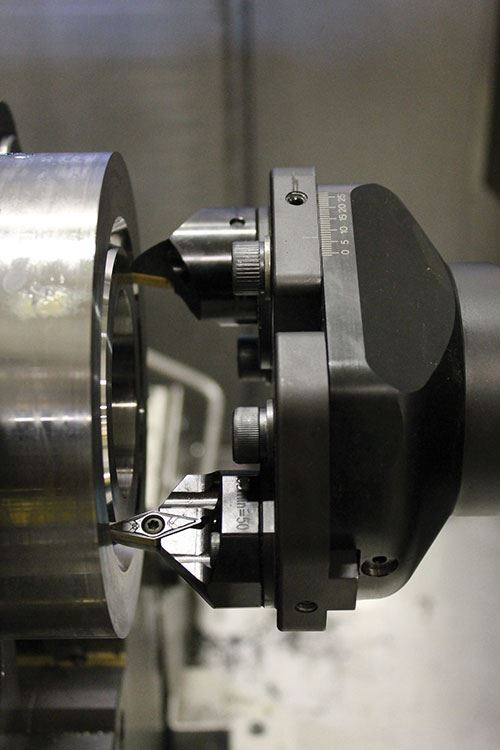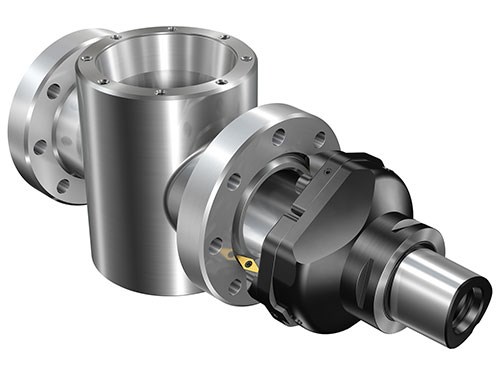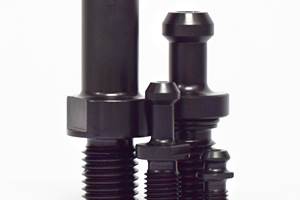“Spirograph” Generates Face Grooves on a Machining Center
Sandvik Coromant's unusual "SpiroGrooving" system uses an adjustable toolholder to machine API grooves on a machining center.
Using a lathe to machine a groove into the face of a turned part requires different toolholders for different groove diameters. That fact is second nature to many shops, but it is a curiosity to shops that don’t do this grooving. The reason different groove diameters need different tooling becomes obvious upon seeing the operation: The blade of the toolholder has to descend with the cutting insert into the groove as it is machined. Since the blade has to fit without touching either the inner or outer wall of the groove, it needs a curvature to match. This is why machining grooves through face turning presents the problem of additional tooling inventory for every different increment of groove size. And arguably, that is the least of the challenges with this operation.
Face grooves are also often a feature on parts that are poorly suited to turning. An example is oil-industry valve bodies, which might have different flanges that get these grooves facing out from one another at right angles. Indeed, another challenge in the oil industry is the specifications of the grooves. The American Petroleum Institute (API), aiming for a tight fit with the seal ring in this groove, requires the groove to hold a tolerance of ±15 minutes on its 23-degree-angled walls and finishes of 32 and 63 microinches RMS on its surfaces. These specs are difficult to hold when plunging a turning tool into the material results in a high-wear operation apt to quickly compromise the cutting edge.
Cutting tool maker Sandvik Coromant has been focused on those very specs in its efforts to develop a more manageable and reliable system for seal-ring groove machining. The unusual solution the company has developed does not use turning at all—or at least not turning on a lathe. Instead, Sandvik’s new “SpiroGrooving” system uses an adjustable toolholder to machine API grooves on a machining center. Two turning and boring inserts are simultaneously rotated and helically interpolated to generate the groove.
The toolholder is an adjustable device that positions the two V-style inserts at a distance appropriate to the groove diameter. Users manually adjust the holder and tighten bolts to clamp it at this diameter. And because of the helical interpolation, this hardware is matched in importance by a software utility that is also part of this system. The user inputs the groove diameter along with the desired cutting pitch and chip thickness (both dependent on workpiece material) to allow this utility to generate the NC code for the tool path particular to this API groove.
The tool path is not a simple helix. As the spindle spins the custom toolholder in time
with the helical orbit inside the groove, each of the two inserts alternates between cutting the inner and outer wall of the groove. The diameter of the helical path then tapers as the cut advances so that the cutting action of the inserts follows the 23-degree slope of the wall. This rotation within a tapering spiral produces a complex resultant tool path that Sandvik describes as an “intelligent spirograph.”
The path is hard to picture—video helps. Watch slow-motion video of the SpiroGrooving tool cutting an API groove.
That video also makes clear how neither of the cutting inserts is overloaded. Each insert moves in and out of the cut throughout its progression through the spirographic path, and each insert alternates between cutting on each of its available edges. The system can therefore cut the groove at a rapid penetration rate without the tool wear that might compromise the groove’s tolerances. As a result, this system is potentially a means of not only simplifying API grooving and moving the operation to a machining center, but also simply cutting the groove more quickly.
Related Content
T.J. Davies Retention Knobs Maximize Cutting Tool Life
Custom-made retention knobs are sized to fit the machine tool and spindle or toolholder to extend the life of existing machine tool assets.
Read MoreIMTS Takeaways From the Modern Machine Shop Editorial Team
The first in-person IMTS in four years left the MMS editorial staff with a lot to digest. Here are a few of our takeaways from the show floor.
Read MoreQuick-Change Tool Heads Reduce Setup on Swiss-Type Turning Centers
This new quick-change tooling system enables shops to get more production from their Swiss turning centers through reduced tool setup time and matches the performance of a solid tool.
Read MoreHaimer USA Models a Streamlined Toolroom
Haimer USA is celebrating its 20th anniversary with a live demonstration of its digital toolroom. Find out more past the aluminum panther.
Read MoreRead Next
3 Mistakes That Cause CNC Programs to Fail
Despite enhancements to manufacturing technology, there are still issues today that can cause programs to fail. These failures can cause lost time, scrapped parts, damaged machines and even injured operators.
Read MoreThe Cut Scene: The Finer Details of Large-Format Machining
Small details and features can have an outsized impact on large parts, such as Barbco’s collapsible utility drill head.
Read MoreObscure CNC Features That Can Help (or Hurt) You
You cannot begin to take advantage of an available feature if you do not know it exists. Conversely, you will not know how to avoid CNC features that may be detrimental to your process.
Read More
.jpg;width=70;height=70;mode=crop)



























